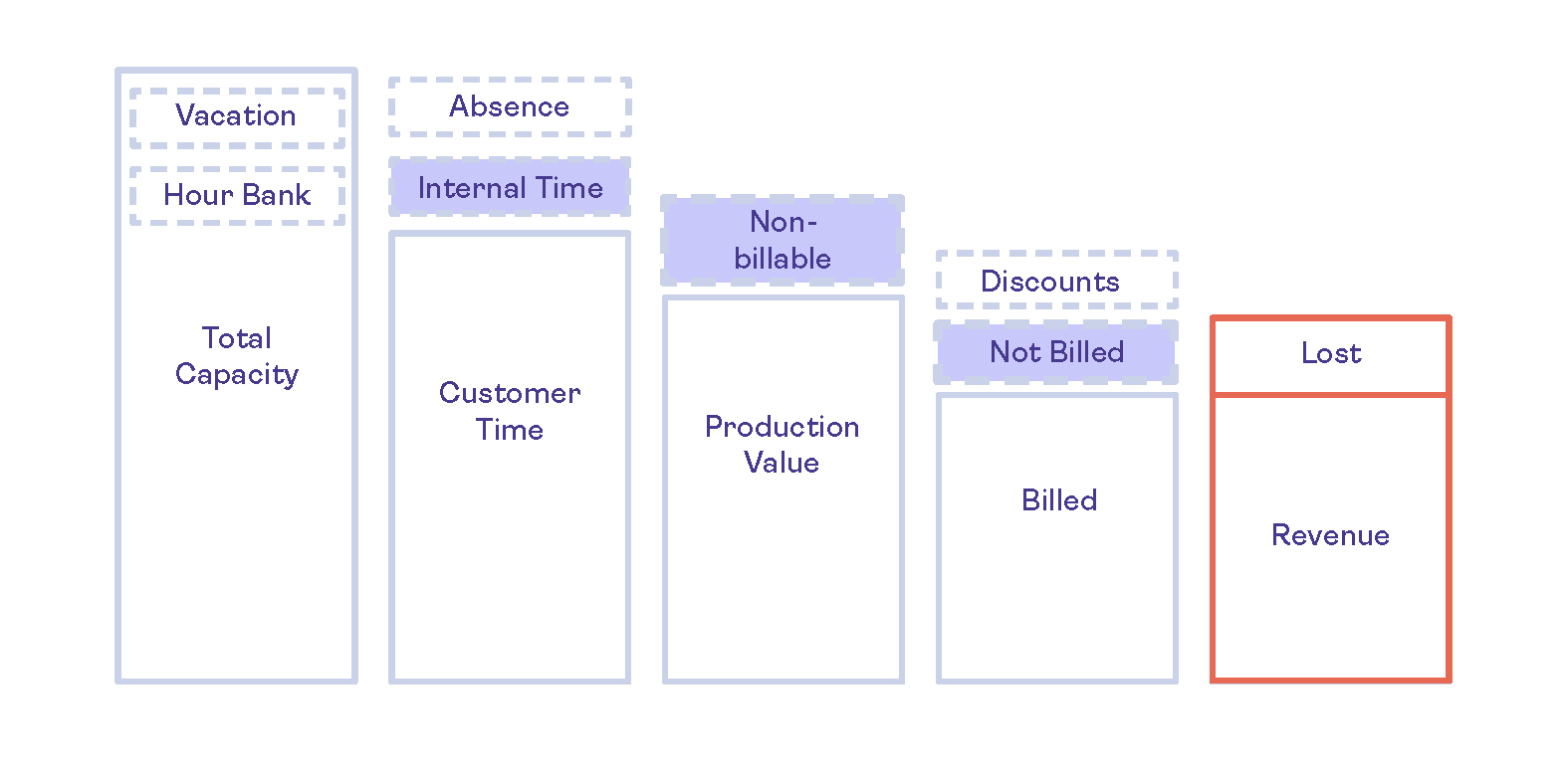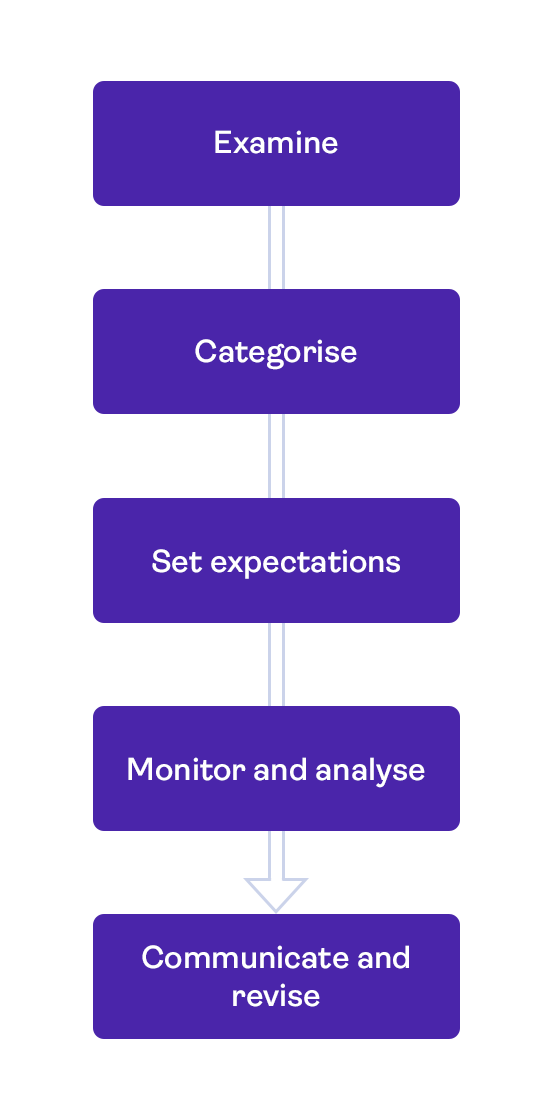Find the revenue leaks in your business
A step-by-step guide to mapping the areas where you can capture untapped revenue in your business.
/Graphics%20for%20templets/image68.png?width=1920&height=574&name=image68.png)
Introduction
Having a solid grasp of your company's financial health is essential for anyone in a leadership position, whether you're at the executive level or leading a team. It's crucial to maintain control over:
- Your company's profitability
- Untapped Revenue
We address the first point in another guide: A Guide to Enhancing Profitability in Projects.
Do you have feedback on the guide, or wish to dive deeper into any of the advice shared? Feel free to reach out to us.

In this guide, we'll reveal how you can pinpoint the sectors within your business where untapped revenue lies dormant.
-
Where are you losing revenue?
-
Where can you find low-hanging fruit to harvest untapped income?
Even minor tweaks in each area can lead to significant impacts on your company's bottom line. By the end of this guide, you'll be presented with practical numerical examples to illustrate this point.
Before you dive in: Ensure your data foundation is solid
To maximise the benefits of this guide and effectively implement its methods, it's crucial that you have access to accurate and up-to-date data from your business. Moreover, there needs to be a unified understanding of what the data reveals across your organisation. Without this consensus, making informed decisions on how to operate your business becomes a challenge.
1. Calculate Your Business's Maximum Capacity
The very first step is to calculate your business's total production capacity. This figure is a key indicator of your organisation's potential earnings. Under ideal circumstances, where no one is absent due to illness and everyone is working at full capacity, you will achieve this level of income.

Calculating the total capacity is achieved through the following formula:
Number of employees * working hours per year * average hourly rate.
Additionally, it's important to subtract vacation time to achieve a more accurate starting point.
2. What Proportion of Capacity is Devoted to Client Work?
In this phase, we delve into assessing how much of the company's working capacity is allocated to absences and internal tasks, with the aim of uncovering how much time is effectively left for client-focused projects.
Absences and internal tasks, while not directly contributing to client services, still consume valuable resources. It is in these areas that there often lies a significant opportunity to optimise time management.

2.1 Gaining Insight into Absence Rates
Understanding the scope of absence is crucial for the economy. Begin by obtaining a comprehensive view of the absentee figures within your company and analyse the absence rate.
Ask yourselves: Does this percentage align with industry norms, or does it exceed the average?
An absence rate that exceeds the industry average signals a potential area for improvement. In such instances, it's crucial to explore which strategies could be implemented to enhance the situation and decrease absence.
2.2 Organising Internal Time
Internal time often acts as a catch-all category in time tracking: It's not unusual for 10-25% of logged hours to be categorised as internal time, without a clear understanding of what this time is actually spent on.
While certain types of internal time are beneficial, assessing and structuring the use of internal time is crucial for improving efficiency and clarity in time management.
Here’s how you can effectively structure your internal time:

Examine
Begin by examining the hours logged by employees to determine the proportion allocated to internal activities.
Delve deeper into what these hours are actually spent on. Look at the timesheets and engage with employees to understand the reasons behind the hours marked as internal time.
Categorise
Create categories for the different types of internal hours, based on your findings from the previous step. These could, for instance, include:
- Enhancement of competence
- Training
- Administration
- Downtime
A well-defined categorisation makes it easier for employees to log their time methodically, paving the way for insightful analysis of time usage trends over time. With this data, management can pinpoint areas requiring attention.
For instance, if the analysis reveals that a significant portion of internal time is devoted to resolving IT issues, it may indicate the need for equipment upgrades or additional training on current systems.
Setting Expectations
Set clear expectations for employees regarding what constitutes acceptable use of internal time. By setting clear guidelines, you ensure that time is utilised in a manner that benefits the company. Spending time on development and training is encouraged, but time spent on administrative tasks and idle time should be kept to a minimum.
Make sure to communicate these guidelines clearly to all employees.
Monitoring and Analysing
Keep a close watch on how time is being used and analyse it regularly.
To ensure the company is moving in the right direction, it's vital to conduct regular analyses of time usage against the established expectations. This enables the implementation of necessary improvement measures. Engage employees in the process by sharing progress and explaining the significance of these measures for the company.
3. Separate customer work into billable and non-billable hours
At this stage, after deducting internal hours (and absences) from your work hours, you are left with the time devoted to your clients.
- Billable time encompasses the efforts that contribute to production value, directly generating worth for your clients.
- Non-billable time includes those hours spent on client work that cannot be invoiced. It's crucial to gain control over this time.

Structuring Non-Billable Time
If considerable time is spent on client work that cannot be billed, it's essential to analyse this time expenditure and map out the reasons behind it.
Just as with internal hours, the secret to managing non-billable time lies in structuring it into clear categories to better understand its usage. Follow the same steps we outlined for internal time. This approach will enable you to pinpoint the reasons behind this time expenditure, such as:
- Misunderstandings
- Work needing to be redone
- Longer-than-usual training periods
Identify the Root Causes and Implement Solutions
Once the root causes are identified, addressing them becomes more straightforward. For instance, if there's a significant amount of time being logged for redoing tasks, it's crucial to delve into the underlying reasons and devise appropriate measures.
- Are there specific clients or types of project tasks that frequently lead to revisions?
- Is it possible that the quality of client communication isn't up to par?
- Would involving a team member with different expertise improve the situation?
4. Map out the proportion of billable hours that are actually being billed
Once you've calculated the production time, the next move is to assess how much of the billable hours actually translate into issued invoices.

Failure to bill is an unnecessary loss of revenue, surprisingly prevalent among small to medium-sized businesses due to inefficient billing routines. Often, invoices are not dispatched in a timely manner, and as time progresses, the quality of these invoices degrades. This makes the collection more challenging at a later stage.
Streamline Your Billing Process
To mitigate this loss, it's imperative to establish a standardised billing process. Implement clear and consistent procedures for invoice creation and dispatch. This approach will not only ensure a more streamlined management of billable hours but also enhance the likelihood of receiving payment for completed work.
For more detailed tips and best practices on billing routines, we recommend checking out our blog post on improving your invoicing strategies.
5. Losses from Unpaid Customer Invoices
Customers who fail to settle their bills constitute a significant source of revenue loss. Similarly, the value of accounts receivable diminishes over time, making the collection of outstanding amounts more challenging.

Establish efficient follow-up routines
To counteract the financial losses from unpaid customer bills, establishing robust routines is critical. Early follow-up on customer accounts receivable is key.
Set up an alert system that automatically reminds you to contact the customer as an invoice nears its due date or immediately after a payment becomes overdue.
Direct dialogue
Do not hesitate to initiate a direct dialogue by calling the customer. A friendly conversation can often clear up misunderstandings or identify solutions to payment issues before they worsen.
In Summary: Do These Steps Truly Make a Difference?
By implementing the methods and following the steps outlined in this guide, you will gain a comprehensive overview of your business. This will empower you to pinpoint the areas in your operations where you're not fully tapping into your income potential.
Addressing these areas – from internal and non-billable hours to billing practices and accounts receivable management – goes beyond mere theoretical improvements. In practice, these measures can have a direct and positive impact on your company's bottom line. By mastering these aspects of your business, you can unlock significant financial rewards and ensure a more stable and profitable operation.
Small tweaks can yield significant results
In the table below, we've laid out a financial snapshot of a company. Here, you'll see the tangible impacts that minor adjustments in each of the steps we've discussed can have on revenues.

Where should you begin? Here's our advice
Addressing internal and non-billable time is often the low-hanging fruit. By implementing structured processes to analyse and minimise unnecessary internal time, as well as optimising the allocation between billable and non-billable hours, you can plug significant revenue leaks.
Additionally, establishing efficient billing routines is critical. By ensuring that all billable hours lead to issued and paid invoices, you avoid losing precious income. A standardised billing process, accompanied by proactive management of customer receivables, will enhance your cash flow.
Seeking even greater project financial health?
Interested in further enhancing your project's financial health? We suggest exploring the concept of billing efficiency, a topic we've extensively covered on our blog.
To gain complete control over your business's financial health, it's also crucial to delve into its profitability. We've crafted a guide featuring 16 strategic moves to boost your profitability, which we highly recommend you explore.

Enhance the Flow of Your Projects
We'd love to have a chat about how Milient can untangle your project knots and put you in charge of your finances!
.png?width=1024&height=1024&name=New%20Merge%20Boost%20Post%20(600%20x%20338%20px).png)
.png?width=1024&height=1024&name=thumbnail_Milient-x-Cubic-Interactive-Press-Release-(2).png)
